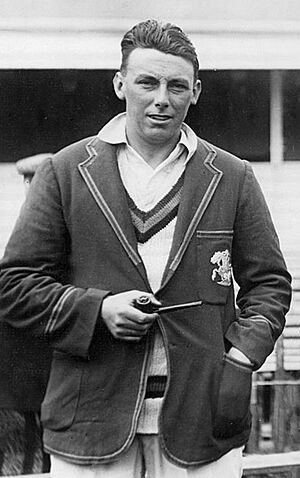Maurice Tate facts for kids

Tate in 1926
|
||||||||||||||||||||||||||||||||||||||||
| Personal information | ||||||||||||||||||||||||||||||||||||||||
|---|---|---|---|---|---|---|---|---|---|---|---|---|---|---|---|---|---|---|---|---|---|---|---|---|---|---|---|---|---|---|---|---|---|---|---|---|---|---|---|---|
| Born | 30 May 1895 Brighton, Sussex, England |
|||||||||||||||||||||||||||||||||||||||
| Died | 18 May 1956 (aged 60) Wadhurst, Sussex, England |
|||||||||||||||||||||||||||||||||||||||
| Batting | Right-handed | |||||||||||||||||||||||||||||||||||||||
| Bowling | Right-arm fast-medium | |||||||||||||||||||||||||||||||||||||||
| Role | All-rounder | |||||||||||||||||||||||||||||||||||||||
| International information | ||||||||||||||||||||||||||||||||||||||||
| National side | ||||||||||||||||||||||||||||||||||||||||
| Test debut | 14 June 1924 v South Africa | |||||||||||||||||||||||||||||||||||||||
| Last Test | 27 July 1935 v South Africa | |||||||||||||||||||||||||||||||||||||||
| Career statistics | ||||||||||||||||||||||||||||||||||||||||
|
||||||||||||||||||||||||||||||||||||||||
|
Source: CricInfo, 6 November 2022
|
||||||||||||||||||||||||||||||||||||||||
Maurice William Tate (born May 30, 1895 – died May 18, 1956) was a famous English cricketer. He played in the 1920s and 1930s. Maurice was a key bowler for England's Test team for many years. He was also the first player from Sussex to take a wicket with his very first ball in a Test match.
Contents
Maurice Tate's Cricket Journey
Maurice was the son of Fred Tate, who was also a cricketer. His dad played as an off spinner for Sussex. Maurice was nicknamed "Chubby." He started his cricket career with Sussex in 1912. Back then, he was known as a strong batsman and a spin bowler.
Early Batting Success
Maurice played a few matches in 1913 and 1914. By 1919, he became a regular player. He scored over a thousand runs for eleven years in a row. This showed he was a very good batsman. In 1921, he even scored 203 runs in one game against Northamptonshire. This was his highest score ever in first-class matches. During these early years, his bowling was not his main strength.
Becoming a Fast Bowler
In 1922, Maurice had more success as a bowler. This was partly because some opposing teams were not very good at batting. A famous moment happened during practice with his captain, Arthur Gilligan. Maurice bowled a faster ball, and it knocked over the stumps.
Captain Gilligan told him, "Maurice, you must change your style of bowling immediately!" After this, Maurice became a tireless fast-medium bowler. He is even called the founder of modern seam bowling. Seam bowling is when the bowler makes the ball move sideways after it bounces. Maurice wasn't super fast in the air, but his balls seemed to gain speed after hitting the ground.
He had an easy, smooth way of bowling. His strong build allowed him to bowl a lot. In 1925, he bowled 9,567 balls. This is a huge number for a medium-pace bowler. At this time, he was still often opening the batting for Sussex too!
Amazing All-Rounder
From 1923 to 1925, Maurice was incredibly successful. He did well in both county cricket and Test matches. In each of these three years, he took over 200 wickets. A "wicket" is like getting a player out. Even though he bowled so much, his batting didn't suffer. His team, Sussex, was not very strong at batting. Also, his captain Gilligan couldn't bowl much after 1924 due to an injury. This meant Maurice had to do even more work.
Test Match Highlights
In 1924, Maurice made his Test debut. In his first Test match, he and Gilligan bowled out South Africa for only 30 runs! This happened in just 12.3 overs. Maurice took 4 wickets for 12 runs, and Gilligan took 6 wickets for 7 runs.
Later, he toured Australia in 1924–25. Australian pitches were usually very hard for English bowlers. But Maurice took 38 wickets in that series. This is still the record for an Englishman in an Ashes series in Australia. He bowled over 600 balls in three of the five Tests. He did this with almost no help from other bowlers.
Later Career and Records
For the next six years, Maurice continued to be a great all-rounder for Sussex and England. His batting was at its best in 1927. That year, he scored five centuries for Sussex. In 1929, he scored his only Test century against South Africa.
After 1930, his batting became less strong. He still bowled very well, but he batted lower down the order. New fast bowlers like Harold Larwood and Bill Voce joined the England team. This meant Maurice was not always needed for England. However, he was still a match-winner for Sussex. In 1932, he took 164 wickets for his county.
Maurice went on a third tour to Australia but did not play a Test match. Even when Larwood was not available in 1934, Maurice was not chosen for any Test.
In 1936, Maurice's bowling started to slow down. He was more expensive, meaning opponents scored more runs off his bowling. After 1937, Sussex decided not to keep him on their team. He retired but remained interested in cricket until he passed away.
Amazing Achievements
Maurice Tate holds many impressive records:
- He took the most wickets in a season outside England. He took 116 wickets in India/Ceylon in 1926–27. He also scored 1,193 runs that season. He is the only player to achieve a "double" (1,000 runs and 100 wickets) outside England.
- He achieved the "double" of 1,000 runs and 200 wickets in a season for three years in a row (1923, 1924, and 1925).
- He took 2,784 wickets in his career. This is the 11th highest number ever!
- He scored 21,717 runs in his career. He is one of only nine people to get a career "double" of 20,000 runs and 2,000 wickets.
- He took three "hat tricks" in his career. A hat trick is when a bowler takes three wickets in three balls.
- He was named Wisden Cricketer of the Year in 1924.
- Maurice Tate was also one of the fastest scorers in Test cricket history.

